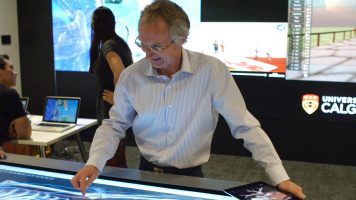Take a look at the people behind the research, product, company or groundbreaking discovery. The ASTech Foundation’s Humans of Alberta Innovation campaign shows a new side to Alberta’s fascinating innovation community — the human one.
Dr. Christian Jacob is the director of the LINDSAY Virtual Human Project, which won the 2015 Innovation in Information and Communications Technology Award. The LINDSAY team uses virtual imaging technologies to help teach human anatomy in new and exciting ways.
I’m Not a Typical Computer Scientist 
Growing up, I wanted to become a Latin teacher. I liked Latin as a very algorithmic language, almost mathematical.
I moved to Calgary in two stages. In 1996, I was looking for someone working in plant simulation because I did my PhD in plant growth programs. We would see how a tree grows, or how the petals fall off flowers and then combine it with an evolutionary program. I connected with a graphics prof at the University of Calgary and that brought me here as a post doctoral fellow. Then, the computer science department had openings which brought me to U of C in 1999 as an assistant professor. I was just going to try it out for two or three years to see how I liked it. I really liked the university and the colleagues; it was a young department and I found some good research projects. That’s why I stayed and why I’m still here.
I’m not a typical computer scientist; I’ve always looked at the computer as a think tool and nothing more. I was first interested in biology because of the brain. I did my diploma thesis on building artificial neural networks. I wanted to know how neurons work, how the brain works and how much of this can be transferred to computers as think tools, to help classify patterns and understand speech.
Eventually I got into simulating immune systems. Suddenly I was inside the body and looking at physiology and how the immune system reacts to viruses and bacteria. Then an offer came to start this LINDSAY Virtual Human Project which led me to work with medical students and researchers.
I’m a very graphical person: I must see and illustrate things. The constant development of technology has always fueled my interest in computer science. It went from different user interfaces where there’s just a mouse and a keyboard to touch screens and portable iPads that could react to my input.
When we ventured into 3D, we could put these augmented reality glasses on. Now we can literally enter digital worlds; and bring virtual worlds, that are trapped behind the screen, into the real world and combine them. All this technology innovation helped create the things I only imagined we could do a few years earlier.
With the LINDSAY Virtual Human Project, there’s always an opportunity to build the next prototype. Suddenly I had a project that was integrated into a medical school, and I had to really pay attention to the details regarding medical education, human physiology and anatomy. It’s still being used to train medical students at U of C, which is really cool. I also get to work with a lot of awesome people from other disciplines outside of computer science, including medical educators, physiologists, medical doctors, physicians and the artists and designers who make the program look good. That’s changed my life as a scientist, being on that inter-disciplinary side of computer science.
The Giant Walkthrough Brain added to that. Jay Ingram is a fabulous science communicator and working with him was a great experience. I had to rethink how to present content from a stage, not for an expert audience. Now we had to consider music, stage lighting, a script and we had to set up this giant walkthrough brain with hallways and signs, like a movie set. As a scientist, that was very exciting because I learned how to sell my science. We explained to people how the human brain works and then we told stories through the computer tool. This has changed my perspective on how to sell and promote science.
I’m excited to venture even more into story telling, especially around the human body; people learn well through stories. Now computer games are the vehicles to create engaging stories. In the end, I hope I can keep inspiring students.
